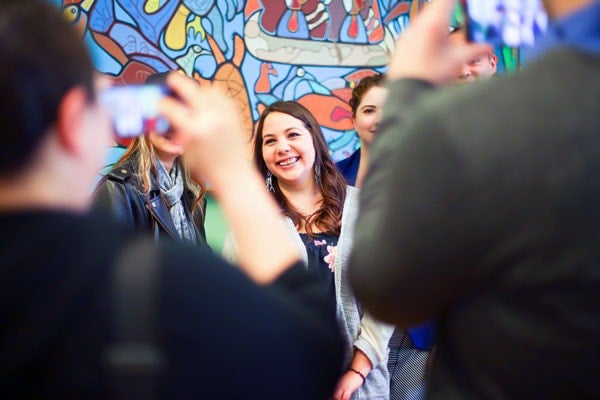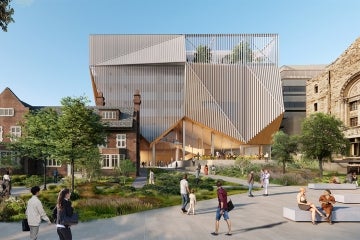
Convocation 2015: meet the Faculty of Law's Shardae Fortier
Published: June 3, 2015
Shardae Fortier’s path to law school was riddled with challenges.
On her mother’s side, she’s Ojibwe, part of Canada’s First Nations people – a population that statistically lags the rest of the nation in education. Fortier grew up in a small town near Thunder Bay with limited opportunities. And, since high school, she’s battled debilitating medical issues.
Yet, despite these odds, Fortier was the first in her family to acquire an undergraduate degree. And this week, as family and friends applaud, she will cross the stage at the University of Toronto's Convocation Hall to receive her law degree.
“I want to make a difference in the aboriginal community, be a voice for my people,” Fortier said. “To this day, my Indigenous community continues to support my educational pursuits. It is for these reasons that I am passionate about working with and for indigenous communities.”
For many indigenous people, getting to college is an unattainable dream. Nearly 40 per cent of indigenous students don’t complete high school. The horrors of the residential school system and efforts at cultural assimilation continue to make First Nations communities deeply distrustful of education. Indigenous communities also have faced an ongoing battle with poverty, violence and substance abuse, making college a difficult proposition for many young Indigenous people.
Acknowledging these obstacles, U of T’s First Nations House holds a special ceremony every year, honouring graduating students of indigenous background. Fortier was among those celebrated at this year’s event.
First Nations House, which provides year-round social, academic and financial supports to Indigenous students on campus, says they’re aware of 45 graduates this year with a declared Native Canadian background. They’re also noticing that increasingly indigenous students – many of whom were historically mature adults returning to school – are now younger students, coming to university straight out of high school.
“There’s a big push to create access,” said Jonathan Hamilton-Diabo, director of First Nations House. “It’s not enough to say we have to do something for aboriginal students – they need to see that they have a chance.”
Part of that is thanks to a full-time recruiter at First Nations House for the last 15 years who has helped bring students to university straight out of high school. There’s also been a cultural shift among young Native Canadians wanting to pursue higher education. Many of the students graduating this year said programs offered at First Nations House helped them feel welcomed on campus and gave them a sense of community.
“There’s a lot of cultural support here that you can’t get elsewhere,” says Victoria Herrera, a young mother who joined U of T through the Millie Rotman Shime Academic Bridging program, which helps older students close gaps in their secondary school education so they can pursue a university degree. Herrera starts at OISE in the fall, working on a master's in adult learning and community development.
“In day-to-day interactions, you can feel isolated in a big university. We can smudge here. We can have spiritual practices. We don’t have to leave who we are at the door.”
Besides creating a welcoming home on campus, First Nations House is also part of U of T’s Council of Aboriginal Initiatives, an advisory group created six years ago consisting of community elders, student, faculty and U of T administrators. This past fall the council crafted a statement acknowledging that U of T sits on traditional land belonging to the Huron-Wendat, Petun First Nations, the Seneca and the Mississaugas of Credit River. Last month, the statement was read during the convocation ceremony at Emmanuel College of Victoria University.
In the future, as more First Nations students enter U of T, Hamilton-Diabo would like to see them pursuing other fields besides go-to careers like education, health and aboriginal studies chosen by most indigenous students. He’d like to work at recruiting more aboriginal students into fields like engineering, architecture and business.
For Fortier, 28, her dreams of becoming a lawyer began at a young age. Even though she excelled academically, education was never a priority at home – not because of the residential school experience but because most people in her town of 400 worked in paper mills or the bush. They didn’t need a degree to get a job.
But Fortier was determined to pursue life beyond her small town. At 16, she and two other Dorion residents raised more than $17,000 so they could run a marathon in Belgium for the Arthritis Society. She never asked her parents about going to university – she just applied and received scholarships that helped pay for tuition at Carleton University, where she studied psychology and business.
At U of T Law, the Aboriginal Law Students Association has allowed Fortier to connect with other Indigenous students.
“They were people very similar to me in backgrounds and experiences learning a system that has suppressed our people for so long, to try and see how the system can be used from within,” she says.
The Faculty of Law’s Aboriginal Law program coordinator opened new doors for her, telling Fortier about opportunities such as the June Callwood Fellowship in Aboriginal Law, which enabled her to work last summer with Falconers LLP, counsel for Nishnawbe Aski Nation representing 49 First Nation communities in northern Ontario. She is articling with them again this summer.
Participating in U of T’s Aboriginal Law program also meant Fortier could travel to the Supreme Court of Canada to view arguments in the R. v. Kokopenace case, arguing for representation of aboriginal people living on reserves on jury rolls in Ontario. She was invited to annual dinners with Ontario Superior Court Justice Todd Ducharme, a Métis and U of T Law school alum, and worked as co-editor-in-chief this year of the school’s Indigenous Law Journal.
Fortier still struggles with her medical issues – an autoimmune disease that keeps her diet restricted to 10 safe foods, and dislocated jaws – but she works hard at not letting them slow her down.
On June 5, her parents and fiancé will be on hand to watch her walk in her robe and collect her law degree.
“My family is realizing that education is important now, more than it was during their generation,” she says. “They are happy to have a lawyer in the family.”



